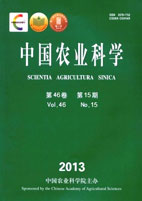-
Effect of Soil-Water Conditions on Survival Rate and Morphological Plasticity of Clonal Plant Mikania micrantha H.B. Kunth
- XU Gao-Feng, SHEN Shi-Cai, ZHANG Fu-Dou, LI Tian-Lin, ZHANG Yu-Hua
-
Scientia Agricultura Sinica. 2013, 46(15):
3134-3141.
doi:10.3864/j.issn.0578-1752.2013.15.007
-
 Abstract
(
646 )
Abstract
(
646 )
 PDF (537KB)
(
782
)
PDF (537KB)
(
782
)
 Save
Save
-
References |
Related Articles |
Metrics
【Objective】The objective of this study is to research the morphological plasticity on clonal reproduction and plant morphologic characters under different water conditions of Mikania micrantha H. B. Kunth which is considered one of the most invasive and destructive species in the world, and to strengthen capability in early warning and control. 【Method】Soil-water conditions on drought and flood were simulated in the artificial climate box, and the survival rate on different phytomers of clonal plant M. micrantha were tested, then in a greenhouse, four types of soil-water conditions of low, medium, high and flood were simulated, respectively, and morphological characteristics, biomass accumulation and biomass allocation patterns were measured. 【Result】In addition to the internode and adventitious roots, soil water content had a significant effect on survival rate of vegetative phytomers of M. micrantha, and the survival rate of different vegetative phytomers was different at the same soil water content. When the soil water content was 12.5%, the survival rate of adventitious root + node, adventitious root + root stock + node was significantly higher than others, while the leaf could not live. Then as the soil-water content increased, clonal reproducibility of vegetative phytomers of M. micrantha was gradually strengthened. At the drowned conditions, when the water depth at 1cm, the internode, node, adventitious root, adventitious root+ node could not live, but the survival rate of other phytomers was more than 80%. All the vegetative phytomers of M. micrantha couldn’t survive at the water depth 6 cm. As the soil water content increased, the main stem length, total branch length, leaf area and internode length of M. micrantha increased. Branch number reached peak in high soil water content, but no significant difference with other treatments. In medium soil water content, stem node reached maximum, then gradually decreased with soil water content increase. Biomass accumulations and allocation of above-ground, stem and leaf increased with soil water content increase. In medium soil water content, biomass allocation of stem reached the maximum. Underground biomass reached maximum in the highest soil water content, but decrease in the drowned conditions, but the allocation of underground biomass decreased with soil moisture content increase. 【Conclusion】 Soil-water conditions had an obvious effect on clonal reproduction ability and morphological plasticity characteristics of M. micrantha, and it could clonal reproduction and growth in the drought (12.5% water content of the soil) and flood (the water depth at 1 cm) conditions, but it could not survive in the water depth 6 cm.









